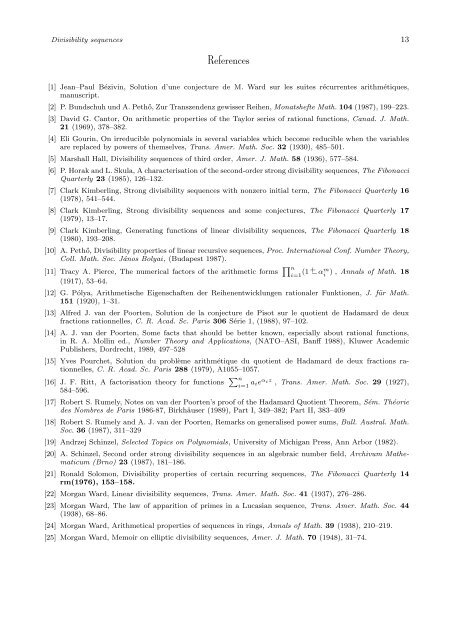A FULL CHARACTERISATION OF DIVISIBILITY SEQUENCES ...
A FULL CHARACTERISATION OF DIVISIBILITY SEQUENCES ...
A FULL CHARACTERISATION OF DIVISIBILITY SEQUENCES ...
Create successful ePaper yourself
Turn your PDF publications into a flip-book with our unique Google optimized e-Paper software.
Divisibility sequences 13<br />
References<br />
[1] Jean–Paul Bézivin, Solution d’une conjecture de M. Ward sur les suites récurrentes arithmétiques,<br />
manuscript.<br />
[2] P. Bundschuh und A. Pethő, Zur Transzendenz gewisser Reihen, Monatshefte Math. 104 (1987), 199–223.<br />
[3] David G. Cantor, On arithmetic properties of the Taylor series of rational functions, Canad. J. Math.<br />
21 (1969), 378–382.<br />
[4] Eli Gourin, On irreducible polynomials in several variables which become reducible when the variables<br />
are replaced by powers of themselves, Trans. Amer. Math. Soc. 32 (1930), 485–501.<br />
[5] Marshall Hall, Divisibility sequences of third order, Amer. J. Math. 58 (1936), 577–584.<br />
[6] P. Horak and L. Skula, A characterisation of the second-order strong divisibility sequences, The Fibonacci<br />
Quarterly 23 (1985), 126–132.<br />
[7] Clark Kimberling, Strong divisibility sequences with nonzero initial term, The Fibonacci Quarterly 16<br />
(1978), 541–544.<br />
[8] Clark Kimberling, Strong divisibility sequences and some conjectures, The Fibonacci Quarterly 17<br />
(1979), 13–17.<br />
[9] Clark Kimberling, Generating functions of linear divisibility sequences, The Fibonacci Quarterly 18<br />
(1980), 193–208.<br />
[10] A. Pethő, Divisibility properties of linear recursive sequences, Proc. International Conf. Number Theory,<br />
Coll. Math. Soc. János Bolyai, (Budapest 1987).<br />
[11] Tracy A. Pierce, The numerical factors of the arithmetic forms n i=1 (1 + − αm i ), Annals of Math. 18<br />
(1917), 53–64.<br />
[12] G. Pólya, Arithmetische Eigenschaften der Reihenentwicklungen rationaler Funktionen, J. für Math.<br />
151 (1920), 1–31.<br />
[13] Alfred J. van der Poorten, Solution de la conjecture de Pisot sur le quotient de Hadamard de deux<br />
fractions rationnelles, C. R. Acad. Sc. Paris 306 Série 1, (1988), 97–102.<br />
[14] A. J. van der Poorten, Some facts that should be better known, especially about rational functions,<br />
in R. A. Mollin ed., Number Theory and Applications, (NATO–ASI, Banff 1988), Kluwer Academic<br />
Publishers, Dordrecht, 1989, 497–528<br />
[15] Yves Pourchet, Solution du problème arithmétique du quotient de Hadamard de deux fractions rationnelles,<br />
C. R. Acad. Sc. Paris 288 (1979), A1055–1057.<br />
[16] J. F. Ritt, A factorisation theory for functions n i=1 aieαiz , Trans. Amer. Math. Soc. 29 (1927),<br />
584–596.<br />
[17] Robert S. Rumely, Notes on van der Poorten’s proof of the Hadamard Quotient Theorem, Sém. Théorie<br />
des Nombres de Paris 1986-87, Birkhäuser (1989), Part I, 349–382; Part II, 383–409<br />
[18] Robert S. Rumely and A. J. van der Poorten, Remarks on generalised power sums, Bull. Austral. Math.<br />
Soc. 36 (1987), 311–329<br />
[19] Andrzej Schinzel, Selected Topics on Polynomials, University of Michigan Press, Ann Arbor (1982).<br />
[20] A. Schinzel, Second order strong divisibility sequences in an algebraic number field, Archivum Mathematicum<br />
(Brno) 23 (1987), 181–186.<br />
[21] Ronald Solomon, Divisibility properties of certain recurring sequences, The Fibonacci Quarterly 14<br />
rm(1976), 153–158.<br />
[22] Morgan Ward, Linear divisibility sequences, Trans. Amer. Math. Soc. 41 (1937), 276–286.<br />
[23] Morgan Ward, The law of apparition of primes in a Lucasian sequence, Trans. Amer. Math. Soc. 44<br />
(1938), 68–86.<br />
[24] Morgan Ward, Arithmetical properties of sequences in rings, Annals of Math. 39 (1938), 210–219.<br />
[25] Morgan Ward, Memoir on elliptic divisibility sequences, Amer. J. Math. 70 (1948), 31–74.
















